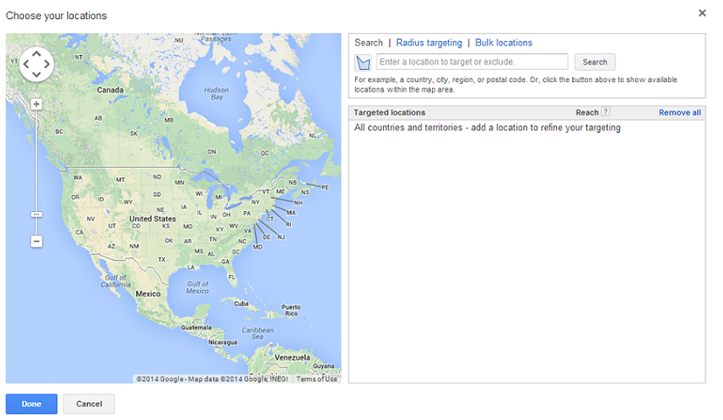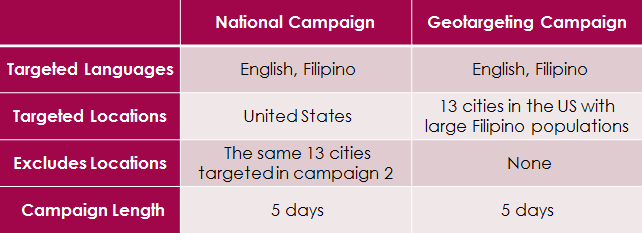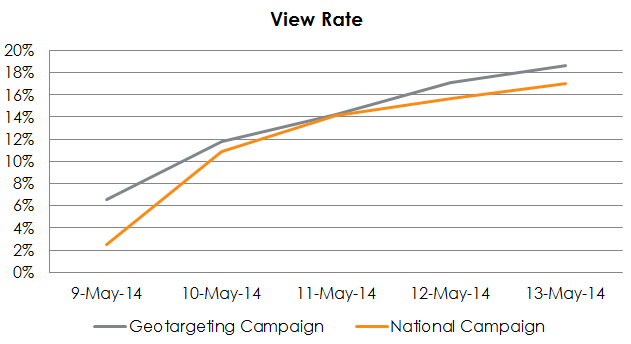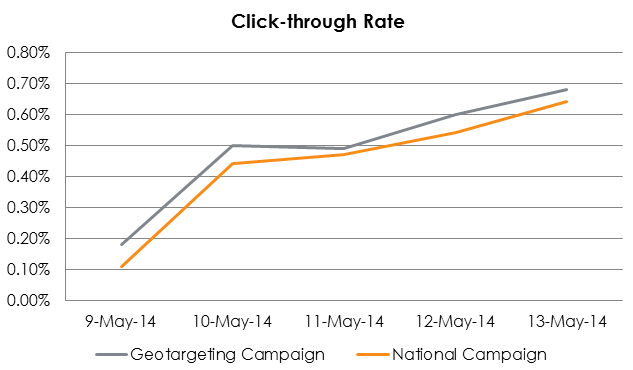Send a Message with Location Targeting
September 18, 2014Advanced location targeting in AdWords gives advertisers total control over where their ads show, with the option of using unlimited target locations. Not only does this setting allow advertisers to pick and choose areas to see their ads based on a business’s logistics, but also allows them to tap into potential interests of their customers that might change from city to city, state to state, or country to country.
What is Location Targeting?
When setting up an AdWords campaign, an advertiser has the ability to select geographic locations to target with their ads under the “Settings” tab. These locations can be countries, regions, cities, and even areas within a radius of a single address. These options allow an advertiser to narrow down their audience to find the right customers. By default, AdWords will show ads to people in, searching for, or viewing pages about the location you’ve chosen to target, but the settings can be changed to include only one of these options at a time.
This campaign setting can give an advantage to a company that provides services dependent on location, and allows them to customize their content to improve relativeness and overall quality of the ads. For example, an online store that ships only in New York State wouldn’t want someone in California clicking on their ads. This case study from WebMetro shows a successful ad campaign managed for a self-storage company that needed to target customers living close to their storage facilities.
Using Location Targeting To Connect With Potential Customers:
In some cases it’s possible to take advantage of targeting options in ways not mentioned in Google’s “Ad Innovations.” Brick and mortar businesses have a clear use for location targeting based on their logistics, but sometimes a particular ad might contain a message that connects with people of certain geographies more than others, whether the product or service being advertised is only available to people in those areas or not.
We recently ran a YouTube campaign involving this type of “message” advertising using a video ad for a well-known CPG brand. The Video originally ran as an ad in the Philippines and featured a song with lyrics in Tagalog, a language spoken by the majority of their population. Our job was to promote the same ad in the United States on YouTube. While the product being advertised wouldn’t inspire customer interest in one location more so than in others, the song in the ad being sung in Tagalog was seen by the brand as an excellent opportunity to connect with the Filipino population in the United States.
Setup:
The ad campaign was to be run for five days, with the overall goal of spending the entire campaign budget within that time. To test the possibility of connecting with the Filipino-American population with the ad, we set up two video campaigns to see if they would respond to the video more so than the rest of US population. The two campaigns, both featuring the same video, were set up in AdWords as follows:
Results:
We can see by the resulting data that the campaign targeting areas with large Filipino populations did perform better than the National Campaign. The view rate was 44% better for the Geotargeting Campaign, with a click-through rate 45% better than the National Campaign. It is important to note as well that the average cost per view for each campaign was the same at the end of the five days that the ads ran.
Consider the Goal of Your Campaign
Unlike companies that use location targeting to make sure they only reach customers that would be interested in their product or service, running a geotargeted campaign to connect to the audience through a message might require different tactics. While a higher view rate shows more engagement from potential customers, it is often the case that the goal of a video campaign is to reach as many potential customers as possible. So instead of only targeting specific locations and reducing reach, advertisers might want to consider setting up multiple campaigns like in this test, and change how they allocate their budget based off of how different areas perform.
Has using location targeting positively impacted your paid search campaigns? If so, share the story below in the comment section









